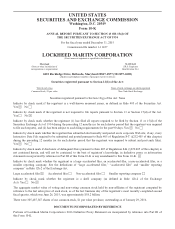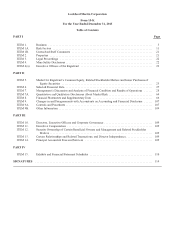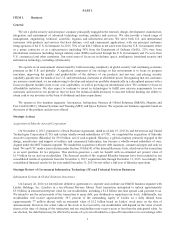Lockheed Martin 2015 Annual Report Download - page 19
Download and view the complete annual report
Please find page 19 of the 2015 Lockheed Martin annual report below. You can navigate through the pages in the report by either clicking on the pages listed below, or by using the keyword search tool below to find specific information within the annual report.
www.lockheedmartin.com/investor, as soon as reasonably practical after we electronically file the material with, or furnish it
to, the SEC. In addition, copies of our annual report will be made available, free of charge, upon written request. The SEC
also maintains a website at www.sec.gov that contains reports, proxy statements and other information regarding SEC
registrants, including Lockheed Martin Corporation.
Forward-Looking Statements
This Form 10-K contains statements that, to the extent they are not recitations of historical fact, constitute forward-
looking statements within the meaning of the federal securities laws and are based on our current expectations and
assumptions. The words “believe,” “estimate,” “anticipate,” “project,” “intend,” “expect,” “plan,” “outlook,” “scheduled,”
“forecast” and similar expressions are intended to identify forward-looking statements. These statements are not guarantees
of future performance and are subject to risks and uncertainties.
Statements and assumptions with respect to future sales, income and cash flows, program performance, the outcome of
litigation, anticipated pension cost and funding, environmental remediation cost estimates, planned acquisitions or
dispositions of assets, or the anticipated consequences are examples of forward-looking statements. Numerous factors,
including the risk factors described in the following section, could affect our forward-looking statements and actual
performance.
Our actual financial results likely will be different from those projected due to the inherent nature of projections. Given
these uncertainties, forward-looking statements should not be relied on in making investment decisions. The forward-looking
statements contained in this Form 10-K speak only as of the date of its filing. Except where required by applicable law, we
expressly disclaim a duty to provide updates to forward-looking statements after the date of this Form 10-K to reflect
subsequent events, changed circumstances, changes in expectations, or the estimates and assumptions associated with them.
The forward-looking statements in this Form 10-K are intended to be subject to the safe harbor protection provided by the
federal securities laws.
ITEM 1A. Risk Factors.
An investment in our common stock or debt securities involves risks and uncertainties. We seek to identify, manage and
mitigate risks to our business, but risk and uncertainty cannot be eliminated or necessarily predicted. The outcome of one or
more of these risks could have a material effect on our operating results, financial position, or cash flows. You should
carefully consider the following factors, in addition to the other information contained in this Annual Report on Form 10-K,
before deciding to purchase our common stock or debt securities.
We depend heavily on contracts with the U.S. Government for a substantial portion of our business.
We derived 78% of our total net sales from the U.S. Government in 2015, including 58% from the Department of
Defense (DoD). We expect to continue to derive most of our sales from work performed under U.S. Government contracts.
Those contracts are conditioned upon the continuing availability of Congressional appropriations. Congress usually
appropriates funds on a fiscal-year basis even though contract performance may extend over many years. Consequently,
contracts are often partially funded initially and additional funds are committed only as Congress makes further
appropriations. If we incur costs in excess of funds obligated on a contract, we may be at risk for reimbursement of those
costs unless and until additional funds are obligated to the contract.
As discussed within the “Industry Considerations” in Management’s Discussion and Analysis of Financial Condition and
Results of Operations, the U.S. Government continues to face significant deficit reduction pressures and it is likely that
discretionary spending by the U.S. Government will remain constrained for a number of years. Under such conditions, large
or complex programs, which consist of multiple contracts and phases, are potentially subject to increased scrutiny. Our
largest program, the F-35, represented 20% of our total net sales in 2015 and is expected to represent a higher percentage of
our sales in future years. A decision to cut spending or reduce planned orders could have an adverse impact on our results of
operations. For more information regarding the F-35 program, see “Status of the F-35 Program” in Management’s Discussion
and Analysis of Financial Condition and Results of Operations.
Based upon our diverse range of defense, homeland security and information technology products and services, we
believe that this makes it less likely that cuts in any specific contract or program will have a long-term effect on our business.
However, termination of multiple or large programs or contracts could adversely affect our business and future financial
performance. Potential changes in funding priorities may afford new or additional opportunities for our businesses in terms
11
























